Charting New Frontiers in Provider Behavior Change Monitoring and Evaluation
Evidence from the field of social and behavior change (SBC) underscores that individual behavior change is more likely to be sustained when supported by social and structural change.1,2 Health care providers need the ecosystem in which they operate to enable and support behaviors that facilitate their delivery of high-quality, respectful care.3,4 Previous programmatic efforts to improve provider behavior and client health outcomes have not fully considered the ever-changing ecosystem and its myriad impacts on providers.5 Breakthrough ACTION is charting new frontiers in provider behavior change interventions by recognizing providers more fully as people and accounting more comprehensively for the complex reality of service delivery.
In charting these new frontiers, Breakthrough ACTON continues to build out a suite of provider behavior change tools and resources that supports the application of a social-ecological lens to the design and implementation of related interventions (Box 1).[i] The first resource developed by Breakthrough ACTION as part of this suite was the Provider Behavior Ecosystem Map, which visualizes the dynamic interplay of factors influencing behavior across the provider ecosystem in which they operate. Subsequent offerings included the Provider Behavior Change Toolkit, which provides a step-by-step process to design and implement complexity-aware provider behavior change interventions through a multi-stakeholder partnership.
| BOX 1. PROVIDER BEHAVIOR AND PROVIDER BEHAVIOR CHANGE INTERVENTIONS
Provider behavior refers to what providers do and do not do in their professional capacity. It includes behaviors before, during, or after an interaction with a client in the health facility or other service delivery setting.3 Provider behavior change interventions aim to positively shape and influence provider behavior by reducing barriers and challenges to behavior change and strengthening facilitators and opportunities for behavior change.3 |
Provider behavior change interventions that are designed and implemented using a social-ecological lens must also be monitored and evaluated with the same lens. Breakthrough ACTION’s latest resource, Approaching Provider Behavior Change Monitoring and Evaluation with a Social-Ecological Lens: New Frontiers Brief, invites program planners and designers to push forward the frontiers of provider behavior change interventions. This brief considers how to identify and measure structural, social, and behavioral determinants of provider behavior across the provider ecosystem: The Individual Provider, Personal Relationships, The Client, Community Context and Social Norms, Workplace Environment, Health System Governance, and Country and Geopolitical Context (Figure 1). It shares insights and findings on what has been done to date to monitor and evaluate provider behavior change interventions across the ecosystem and provides recommendations for what can be done going forward. There is also a set of illustrative indicators that can be consulted when developing monitoring and evaluation plans.
Figure 1. Provider Behavior Ecosystem
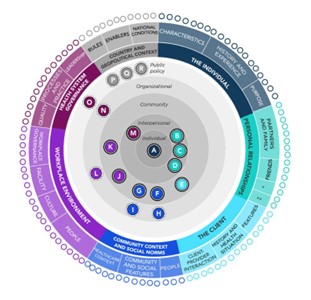
As Breakthrough ACTION charts new frontiers at the intersection of SBC, service delivery, and health systems strengthening, program implementers need to increasingly reflect on what is and what is not being monitored and evaluated and why. Pushing program implementers to consider monitoring and evaluation at each level of the provider behavior ecosystem will expand knowledge and understanding of the ever-changing ecosystem and its myriad impacts on providers.
Resources
- Provider Behavior Ecosystem Map [ English, French ]
- Provider Behavior Change Toolkit for Family Planning [ English, French ]
- How to Measure Provider Behavior Impact [ English ]
- Approaching Provider Behavior Change Monitoring and Evaluation with a Social-Ecological Lens: New Frontiers Brief and Illustrative Indicators [ English ]
Online Course
Written by: Danette Wilkins, Program Officer, Breakthrough ACTION
REFERENCES
- Kincaid, D.L, Figueroa, M.L, Storey, D. & Underwood, C. (2020). A socio-ecological model of communication for social and behavioral change. https://breakthroughactionandresearch.org/wp-content/uploads/2020/12/socio-ecological-model-of-communication-for-sbc.pdf
- Petit, V. (2019). The Behavioural Drivers Model: A Conceptual Framework for Social and Behaviour Change Programming. UNICEF. https://www.unicef.org/mena/reports/behavioural-drivers-model
- Breakthrough ACTION. (2021). Provider behavior ecosystem map. https://breakthroughactionandresearch.org/wp-content/uploads/2022/01/Provider-Behavior-Ecosystem-Map-Guide.pdf
- Hancock, H., Carlson, O., Hempstone, H., Arnold, B., Hoffmann, K., Gul, X., & Spielman, K. (2023). Six recommendations for provider behavior change in family planning. Global Health: Science and Practice, 11(Supplement 1), e2200495. https://doi.org/10.9745/GHSP-D-22-00495
- Breakthrough RESEARCH. (2023). How to measure provider behavior change impact. https://breakthroughactionandresearch.org/wp-content/uploads/2023/01/BR_HowTo_MeasurePBC_Brief.pdf
[i] Breakthrough ACTION’s suite of tools focuses on facility-based providers working in family planning and reproductive health service delivery. Its content is also generally applicable to other types of providers (e.g., community health workers) working across different settings (e.g., communities) and health areas (e.g., maternal and child health).

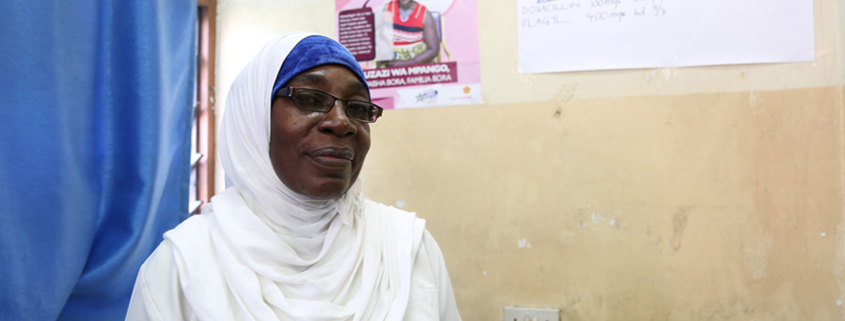 Sheena Ariyapala/Department for International Development
Sheena Ariyapala/Department for International Development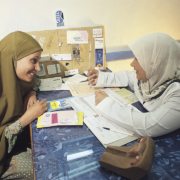 Center for Communication Programs/Photoshare
Center for Communication Programs/Photoshare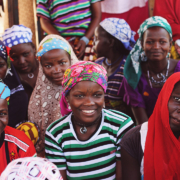 Cambey Mikush/Photoshare
Cambey Mikush/Photoshare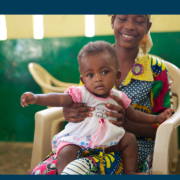 Sara Holbak/VectorWorks/Photoshare
Sara Holbak/VectorWorks/Photoshare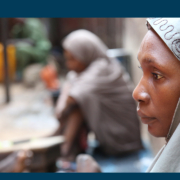
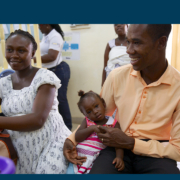 Sarah Hoibak/VectorWorks/Photoshare
Sarah Hoibak/VectorWorks/Photoshare Getty Images/Image of Empowerment
Getty Images/Image of Empowerment